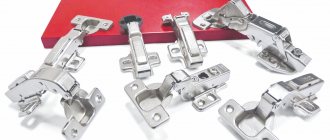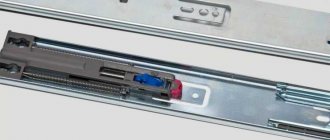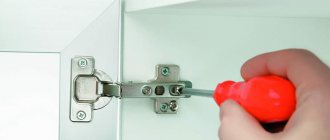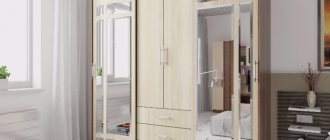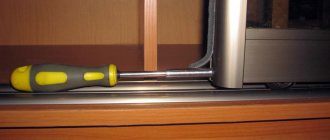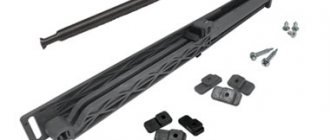Many people, in order to save money, when buying furniture, decide to assemble it themselves, so as not to pay for the services of an assembler if they come for a separate fee. In fact, it is very easy to assemble modern interior items, following the included instructions and having at least minimal skills in working with the tool.
However, there are still some nuances. For example, installing furniture hinges with your own hands is a fairly simple task, but one that requires attention and accuracy, because how well the doors of cabinets and cabinets will close will largely depend on correct installation.
Installing furniture hinges yourself
Furniture hinges: features and types
A furniture hinge is a semi-mechanical design that makes it possible to open and close part of the furniture body (usually a door), retracting it to a certain angle. It is completely invisible from the outside, but at the same time it is capable of not only holding it in the desired position and helping to open the facade (door), but also preventing it from opening without permission. Typically, hinges are used for the so-called hanging of doors made of various materials - wood, glass, aluminum profile. Also, most hinges are capable of closing on their own. The most common type of hinges is four-hinged . They are highly functional and very reliable, durable and can serve for many years without breaking.
Four-joint furniture hinge
On a note! For the first time, a design that can close on its own appeared only in the twentieth century; it was patented in Italy.
History of furniture hinges
The design of a furniture hinge is represented by the following elements.
- The base or base is the element that is attached to the mounting plate. It has a special screw that makes it possible to adjust its position.
- The cup is a part that, during the installation of hinges, is installed in a hole specially drilled in the facade. It has a round shape.
- Hinges are movable elements equipped with spring mechanisms.
Furniture hinge - structure
Each hinge of this type has a spring that allows the design mechanism to hold the cabinet door closed and prevent it from opening without permission. These hinges can be adjusted in three planes at once, which is very convenient and allows you to adjust them perfectly in almost every case. They are made of steel and have high protection against rust.
On a note! Such loops in Russia are also called cup loops or a more prosaic name - frog.
What is it and how does it work?
Hinges with four hinges can be:
- semi-overhead , which are usually used if you need to attach a pair of sashes to one side at once, which will open in different directions. That is, the facade covers only part of the end;
- overhead , which are suitable for installing the door on any side of the body;
- angular , which must be used if the door must be attached at a strictly defined angle (for example, 45, 90 or more degrees). As a rule, the angle depends on the design features of the cabinet;
- inverse , which make it possible to open the door 180 degrees, that is, when the door is opened, one plane is formed with the base wall;
- inset or internal , which allow you to secure the door inside the cabinet. The loop resembles a half-overlay, but is more curved.
Types of furniture hinges
In fact, there are not only four-hinged hinges, although they are the most common and are most often used during furniture assembly to connect the body with the doors. There are also other varieties that we will now get acquainted with.
Installation sequence
To install 180 degree hinges you do not need to have any special skills or knowledge. The product comes with instructions that describe the installation sequence and features in detail. Before work, you need to carefully consider the fastening device, evaluate its strengths and weaknesses.
Hinge installation steps:
Preparation. You need to make sure you have the necessary tools for the job. You need to take a drill, a cutter, a level, a tape measure, and a marker. Marking. It is carried out in accordance with certain rules. The hinges should not be level with the shelves, there should be a distance of 50 cm between the fasteners, and 1.1-1.2 cm should be removed from the edge. Drilling. Holes for self-tapping screws are made in accordance with the markings. Screwing the hinges. The fittings are tightened using screws. Adjustment. Here you need to use a level and a screwdriver
It is important to place the fasteners evenly, to eliminate distortions, cracks, backlashes and other defects.
All nuances must be taken into account at the preparatory stage
When creating markings, it is important to design everything accurately so that the facades do not touch. To do this, use a special tool - a building level.
The depth of the holes depends on the thickness of the doors.
An equally important adjustment step. The correctness of the process determines the functionality of the furniture. You can adjust the depth by adjusting the pressing force of the screws. Twisting oval holes helps to avoid sagging. It is possible to eliminate gaps by lateral adjustment.
Other types of loops
So, all types of loops can be classified in different ways. Thus, there are different types according to design, purpose, method of fixation and application. In general, there are several dozen types of furniture hinges, some are more common, some are less common, but almost all find application in various types of furniture designs. In addition to four-hinged hinges, let's look at a few more variations of hinges that may be encountered by furniture assemblers or people who have bought new interior items and decided to assemble them themselves.
Card loop
Card loops are considered the oldest. Their ancestor is a forged hinged hinge with a long overlay. Outwardly, they resemble an ordinary door hinge, only slightly smaller in size. The design consists of two metal strips connected in parallel using a thin rod that acts as a hinge. Nowadays they are rarely used, but are indispensable in the manufacture of retro-style furniture.
On a note! Such hinges can be collapsible or non-dismountable, with a different number of hinges. Also, sometimes the hinge plates can be shaped.
Butterfly door hinges
Pendulum-type hinges or bar hinges make it possible to open the door 180 degrees. What happens is something similar to how the doors open at the entrance to a saloon in old westerns.
Bar loop
Mezzanine hinge structures are designed to attach horizontally oriented doors that will open upward. The hinges have a spring mechanism and also allow you to fix the door when open. They resemble ordinary overhead variations of loops.
Mezzanine hinge MK01
Ombre structures are used for so-called hinged doors. They will be mounted on both ends of the cabinet and do not require insertion, but may require minor milling (up to 2 mm). Then the sash can be opened 180 degrees. This is an ideal hinge for a folding table.
Hinge for folding elements
Secretory structures are similar to the card ones described above; they have an axial hinge and plates. They make it possible to open the façade downwards and keep it in a horizontal position. They can be accompanied by a special bracket that provides a supporting function. Usually installed in those cabinets where a bar is provided.
Secretory loops
Blind hinges, otherwise called adit hinges , are used for doors on the side of the cabinet that is adjacent to the wall. They can be used to attach the door to the false panel.
Gallery hinges
Heel products are extremely rarely used because they are designed only for lightweight doors. But they can be installed on facades with any type of opening. Installation is carried out in the lower and upper parts of the sash.
Heel loops for furniture
There are special hinges for glass sashes . They also come in different types, but their advantage is that they can withstand significant loads, and they look very beautiful.
Glass hinge
, hinges with 8 hinges, eight-hinged, appeared on sale . To install them, you do not need to resort to milling or cutting. This is an improved variation of the usual four-joint hinge. True, they are more difficult to install, and therefore, despite the absence of the need to carry out any preparation, such loops are rarely used.
8-joint hinge
Repulsion systems
Is it possible to open a cabinet without handles? Can. To do this, you can use the repulsion system. Externally, it is very similar to a shock absorber and even performs its functions. But the main feature of this system is that when you press the door, the pusher moves the door to a distance of up to 6 cm, which allows you to open it further by hand without using the handles. In this way, you can make a facade without handles, and at the same time save a lot of money on the latter.
Fig.35.
Repellers come in mortise and overhead types. They are installed similarly to shock absorbers. The difference in installation is that they must be mounted on the wall opposite to where the hinges are installed. To hold the door, pushers can be equipped with magnets. The repeller operation is adjusted by rotating the rod, so you can select the optimal repulsion value.
Repulsion systems can be used for both doors and drawers, together with any other mechanisms, from hinges to elevators.
What to consider?
If suddenly, for some reason, a person needs to choose and buy hinges on his own, then this issue must be approached wisely. And you need to purchase only high-quality awnings, despite the fact that they all look the same on the display case. It is better to take those that are more expensive, but from a trusted manufacturer, than suspiciously cheap ones. Poor quality hinges can:
- quickly become loose and require constant adjustment;
- start creaking or closing poorly;
- break;
- start to rust.
How to choose furniture hinges
Important! It is worth refusing to buy Chinese hinges. These structures are very unreliable, as a rule, they collapse very quickly and cease to function. Low-quality alloys are used for their production. And China supplies defective hinges to our markets in very large quantities.
By installing cheap hinges, you can save money only in extremely rare cases. Typically, such structures require early replacement, which means additional costs and a waste of time for dismantling the old loop and installing a new one. The miser pays twice - a saying that is very true when it comes to furniture hinges.
How to choose furniture hinges
DIY repair
Over time, furniture hinges may fall out of their installation sockets. There is no need to immediately throw out the closet or change furniture fronts. First you need to remove the loop and carefully widen the hole (10 mm deep). Next, you need to lubricate the wooden dowel with wood glue (or PVA) and drive it into the resulting hole.
We do everything carefully so as not to pierce the material through. After the glue has completely dried, we cut off the protruding part of the dowel with a hacksaw. We tighten the screws that secure the loops directly into the dowels.
How to prepare for installation?
Installing hinges is a simple job and does not require much effort and time, but provided that the person has all the necessary tools at hand and also has certain work skills. For those new to the project, the task of installing a hinge can be very challenging. You can't just screw it on.
So, the most important tool you will need is a Forstner drill . It has a special working part with the same diameter as the hinge bowl (35 or 26 mm). Using this drill, you need to make special holes in a clearly marked place. The hinge bowl will be inserted into it, and the structure will be secured using screws screwed into special ears.
Forstner drill
To install the hinges you will also need:
- screwdriver;
- ruler and square;
- a simple pencil;
- drill with various attachments;
- level;
- self-tapping screws and self-tapping screws.
Cordless screwdriver
It is important to take into account the material on which the loop will be fixed. Thus, fibrous or loose materials are quite soft, glass ones are fragile and at the same time strong, etc. Each material uses its own specific type of fasteners, and in different quantities.
Characteristic
Furniture hinges differ in cup size. The fitting size of 26 mm is called mini. This option is used for lightweight doors. The sheer part of the fasteners is made of plastic. It is inserted into a hole whose size is 26 mm. The cup is secured with a plug on two screws.
You can additionally purchase decorative overlays for the loop. They have different shapes. Overlays perform an aesthetic function. They cover the protruding parts of the fittings, and the door has a finished look. In order for the hinges to last a long time, it is important to ensure high-quality installation with careful drilling.
Work order
Marking is a very important step when installing hinges. It involves marking the door where the hole for the hinge bowl will be drilled. Moreover, it is important to first find the place where the center of the hole will be located. And here it is important to understand that the number of hinges directly depends on the size of the facade itself and its weight . But in any case, you need to retreat about 7-12 cm from the edge of the door. The distance between installed canopies should not be less than 50 cm, provided that several of them are attached.
Hinge Attachment
Table. Required number of loops.
| Options | Number of loops, pcs. |
| Length up to 1 m, weight – no more than 9 kg | 2 |
| Length 1-1.5 m, weight – up to 15 kg | 3 |
| Length up to 2 m, weight – up to 20 kg | 4 |
| Length 2-2.5, weight no more than 20 kg | 5 |
After marking, you will need to make holes for the hinges. They are performed using a special drill. It is best to place the door on a flat, hard surface, this will make it easier to work with. The depth of the recess should be approximately 1.2-1.3 cm. If you make it deeper, there is a risk of damage to the outside of the facade. And you need to drill the hole clearly vertically.
Diagram: loop fitting dimensions
Important! The cutter must be sharp and preferably new.
After drilling, you can install the hinges, and you will also need to adjust them. Only in this case will the door hang straight.
Calculation of the number of furniture hinges for installation
Marking
In order to install the furniture hinge correctly, you need to make markings. Use a regular pencil, ruler and building level. The height from the edge of the facade is 12 cm. The step between the canopies should be fifty centimeters. The width of the space from the edge should be 21 millimeters. Installation of fasteners close to cabinet shelves is prohibited. Such an arrangement will interfere with the normal functioning of the structure.
The furniture hinge is attached to the false panels.
Drilling with a milling cutter is not an activity for beginners.
Advice! If the facade is heavy, then two or more hinges should be installed.
The piano type is used in book tables.
Use any scrap piece of wood.
detailed instructions
Step 1. You need to indent approximately 7-12 cm from the upper and lower edges of the door. In this case, the indentation in the instructions is made at a distance of 8 cm. You need to draw two lines strictly perpendicular to the edge of the door.
An indentation of 8 cm is made
Lines are drawn perpendicular to the edge
Step 2. Next, from the edge of the door to the center of the place where the hole will be drilled, you need to make an indent of 22 mm. This is the standard distance. And you also need to draw lines through the marked point, perpendicular to those drawn earlier.
Bottom space - 2.2 cm
Perpendicular lines are drawn
Step 3. Next you need to take a special drill with a standard diameter of 35 mm.
Take a drill with a diameter of 35 mm
Step 4. To make drilling easier and the drill clearly positioned, you need to make small notches using an awl at the intersections of the lines on the markings.
Using an awl to make indentations
Step 5. Now you can drill the holes. You can do this with a drill, or you can use a special router.
You can start drilling holes
Result of work
Step 6. Once the holes have been drilled, you can try on the hinge bowl, and also, by aligning the holes for the screws on the ears of the bowl along the line drawn earlier, mark where the drilling will be done, but with a thin drill. Moreover, the points will not be on the line itself, but slightly to the side, with the ears aligned along the line.
Fitting the hinge bowl
Markings have been applied for future holes
Step 7. Now, using an awl, you need to make notches at the designated points to position the drill.
Notches are made to position the drill
Step 8. Next you need to drill holes for self-tapping screws measuring 4x16 mm.
Holes are drilled
Step 9. It is necessary to attach the canopy to the door again, placing the bowl in the hole, and screw it to the facade with self-tapping screws.
Screwing with self-tapping screws
Step 10. Now you can attach the door to the cabinet wall. This is done like this - first you need to attach the door to the wall, choosing the position in which it should stand.
Now you can attach the door
Step 11. When applying markings, you need to ensure that the upper hinge screw, which will be attached to the wall, is in a position close to the door itself.
You need to mark carefully
Step 12. Next, it is important, after taking simple measurements, to set aside 17 mm from the center line on which this part of the canopy lay.
From the center line you need to set aside 17 mm
Step 13. After this, you need to attach the door again and make marks with a marker through the holes in the hinge, aligning them with the lines drawn at a distance of 17 mm.
Markers are used to make marks through the holes in the loop.
Step 14. Now you need to drill holes for Euro screws with a drill.
Holes for Euroscrews are drilled
Step 15. Next you need to screw part of the loop to the wall.
Part of the loop is screwed to the wall
Step 16. Then you can attach the door to the wall. It is important to get the front part of the hinge attached to the door onto the screw located on the part of the hinge that is fixed to the wall. Also, under the hinge that is fixed to the door, there is a screw with a “heel”, which is important to get into the groove located on the other side of the part of the hinge that is fixed to the wall.
This part needs to get onto the screw
The door is attached to the wall
It is important to do everything according to the instructions
Another photo of the process
Step 17. To prevent the hinges from coming apart, the outermost screws need to be tightened a little. There is no need to wrap them all the way yet.
The outer screws are tightened a little
Step 18. Now you need to adjust the door. To begin with, you should move it away from the cabinet wall by about 1-2 mm; you do not need to fix it tightly to it. Once the gap has been maintained, the screws can be tightened.
Door adjustment
Step 19. There is another screw that will help you move the door left or right if necessary. In this case, there was no need to adjust it.
This screw in our example did not need adjustment
Video - Marking and drilling
Drilling a hole
The next step in installing furniture hinges is preparing holes for screwing in screws. The holes are made using an electric drill and a small thin drill according to the markings made. In addition, to install the hinge cup, you will need to use a special cutter - with its help, you will need to make a round hole in the door leaf with a depth equal to the depth of the hinge cup. You need to choose a cutter designed for woodworking - otherwise, traces of deformation may appear on the outside of the facade, and chips of the material may appear on the inside plane.
To drill a hole, the cutter must be sharpened - only in this case can you be sure that it will not damage the door material. To work, you will need to fix the cutter in the chuck of an electric drill. The tool is brought to the markings on the door leaf, placed in a strictly perpendicular position, then the drilling process is performed at low speed speeds of the power tool. The depth of the hole is made no more than 12-13 mm. It is necessary to constantly monitor the operation of the tool without increasing the speed of rotation.
Using a cutter requires some experience, so if this is your first time working with such a tool, you should first try your hand at a piece of rough wood. Only after understanding the specifics of the process can you proceed to drilling the furniture facade.
In order to make mounting holes for furniture screws correctly, you must follow the recommendations of specialists:
- when drilling holes for attaching furniture hinges, you must remember that any of them cannot exceed a depth of 13 mm;
- the diameter of the holes must correspond to the size of the hinge fasteners;
- work on drilling holes must be performed carefully and only at low speeds of the electric drill, constantly monitoring the process;
- Having completed the first hole, you need to proceed to the second, and then to the next one - continue this until all of them are completed.
For example, if furniture doors are made of pine or birch, then the drilling process is easy and quick, while ash, oak or walnut are quite difficult to drill due to the high density of their wood. During operation, you must ensure that the drill is always at a right angle to the working surface - if you are drilling dense wood, the tool can easily deviate from the drilling path given to it.
Signs of classification
Awnings can be classified according to a number of defining characteristics:
- Installation location.
- Mechanism connector method.
- Type of attachment to the box.
- Material of manufacture.
- Type of construction.
It should be borne in mind that hinges are selected independently only for doors that are made of MDF or wood (see How to make wooden doors with your own hands - the best solution for any opportunity). Plastic, steel and aluminum products are supplied fully equipped with fittings and canopies.
The location of the hinges determines their type. They can be:
- For entrance structures. They have great strength and overall dimensions. In addition, such products must provide protection against the removal of the doors, which will become an additional obstacle to unauthorized break-in.
- For interior openings. These are simple designs that are lighter and more elegant.
Types: advantages and disadvantages
There is a wide variety of awnings. The main ones are summarized in the table:
| Advantages | Flaws |
| overhead element, types | |
|
|
| Hidden element | |
|
|
| End elements | |
| It is not recommended to heavily load the doors. |
| Mortise | |
| For their manufacture, ordinary steel is used, followed by the application of chromium or nickel. |
| Screw-in | |
|
|
| Corner canopy | |
| These are card canopies shaped like an angle. They have the same advantages. In addition - installation of a hinge on doors with a rebate. | The device cannot be hidden, which spoils the appearance. |
| Double sided canopy | |
| Possibility to open the canvas in two directions. This is very convenient for offices and catering establishments where there are large crowds of people. Otherwise, the products are called bar products. |
Susceptibility to shock loads. Distortion and jamming may occur. |
| Elements on bearings | |
| If the quality of the bearings is poor, the cages may crumble and the balls may fly apart. |
| Door piano products | |
| Such models are morally outdated and have been actively replaced by other types. |
Adjustment in planes
Vertical adjustment
Vertical adjustment of cabinet hinges is the action with which you should begin adjusting furniture fittings. This adjustment is necessary if the door hangs crookedly - it sticks out from the general contour of the furniture, or if there are two doors, one is located higher than the other.
Vertical adjustment of the facade is carried out in 4 successive steps:
- Open the furniture door and look for the hinges. If there are plugs on them, remove them.
- On both hinges, tighten the bolts located closer to the edge of the sidewall. They are responsible for the vertical position of the furniture facade. Both bolts should initially be set to the same value in order to know where to adjust next.
- Close the front door and look at its location in space relative to the overall dimensions of the cabinet. If the upper corner is tilted to the right, it is necessary to tighten the adjustment bolt on the upper hinge more strongly, while on the lower one it must be unscrewed.
- Repeat steps 2-3 until you achieve the optimal position of the facade.
Manufacturers of furniture fittings
Bloom furniture hinges, advantages and disadvantages:
- SCILM. An Italian company that produces high-quality furniture fittings and components, frame profiles, plinths and other products that are used in furniture production.
- Boyard. Ekaterinburg company supplying furniture fittings from China.
- "RosAks" . Moscow manufacturer of furniture fittings.
- VIBO . An Italian company, the largest manufacturer of accessories in its country.
- BLUM. Austrian manufacturer of fittings and solid wood furniture.
- FENNEL . For many years, the Ukrainian company has been a leader in the supply of furniture fittings to more than 60 countries.
- TBM. Domestic manufacturer of metal furniture fittings.
Tips for choosing furniture fittings for the kitchen:
When choosing hinges for cabinet fronts and fillers, you need to pay attention to the following factors:
- Required opening angle and cabinet location.
- Type of lockers (corner, with doors opening up/down, etc.).
- Door weight and length.
- The quality of the metal from which the hinge is made (it is recommended to choose a brass-zinc alloy for covering furniture).
The hinges on the doors may not be the brightest detail of the kitchen façade, but they are one of the most important. After all, the comfortable and reliable use of a furniture set depends on the quality of cabinet fittings.
Adjusting standard sash canopies
The most commonly used are two types of door hinges - the regular type and the one with a closer. Externally, both options are almost the same, the second has a more massive design. The setup technology is common for all types. There are four main conditions that allow this operation to be carried out successfully and in a short time.
Before starting work, you need to ensure that the cabinet is level in three spatial planes. This can be determined using a building level.
The impossibility of optimal arrangement in three spatial planes will require increasing the gaps on the facade sashes. Their dimensions, with the correct arrangement of furniture, are within 3-4 mm.
The adjustment begins by adjusting the vertical gaps along the height of the door. Then the sashes are leveled in height.
Another important point is the correct fit of the facade under the fittings cup. Otherwise, the process of correct regulation is practically impossible, and the additive defect will need to be eliminated.
It is necessary to adjust furniture hinges simultaneously in several planes:
- vertical regulation;
- aligning the door height;
- plane adjustment.
Vertical adjustment is performed when the sash hangs at an angle or one door is lower than the other. The process consists of four stages:
- Removing caps from awnings.
- Installation of bolts at the same level, located away from the edge of the sidewall and responsible for vertical adjustment.
- Covering the sash and determining its location relative to the entire cabinet structure. If the upper corner of the door has shifted to the right side, you need to tighten the adjusting screw in the upper canopy and unscrew it in the lower one.
- The previous operation is carried out until the door reaches the desired position.
Now you can start adjusting the door height. To do this, you will need to purchase adjusting screws with fine threads - 16e PZ, which will firmly hold the mount. Self-tapping screws are thick and should not be used with large thread pitches. In this case, you will have to work with bolts that secure the hinge to the side wall through oblong holes. The process is divided into three operations:
- Loosening screws on awnings by lightly unscrewing them.
- Moving the sash in the required direction (up or down) along the hole and fixing it.
- Carefully tighten the self-tapping screws almost all the way, but so that the threads do not go astray.
Adjusting the hinges according to the plane is required when the door does not press well against the body or when closing it returns slightly. In this case it is necessary:
- Tighten the screws located closer to the edge of the side panel towards you by no more than 2-3 mm.
- Checking the correct location of the door - there is a gap between the leaf or facade.
- If necessary, repeat the process until the defect is eliminated.
It is recommended to make adjustments using a Phillips screwdriver, since the bolts also perform a fixing function and therefore must be firmly tightened.
Adjustment of furniture canopies with closers
Adjustment of furniture hinges with a closer is carried out in the same way as standard ones. However, there is one difference - they add another adjustment screw, which allows you to either turn off the closer or increase the force of attraction.
In some mechanisms, shutdown is carried out using an additional bolt, in others - with a switch located in the hinge cup. This depends on the manufacturer and the design of the canopy, so how to adjust the setting of a certain type of hinge with a closer should be found in the instructions supplied by the manufacturer.
Adjusting furniture canopies yourself
Work on adjusting hinged hinges can be carried out independently, without the involvement of a professional. This simple procedure does not require great professional skills and a significant amount of time. To perform it, you do not need expensive devices - simple tools available in every home are sufficient.
The only condition is a careful study of the techniques, features and sequence of operations for performing such work. Adjusting furniture hinges with your own hands will allow you to regularly check the condition of the facade during the operation of the furniture and promptly eliminate any problems that arise, constantly maintaining furniture fittings in working condition.
